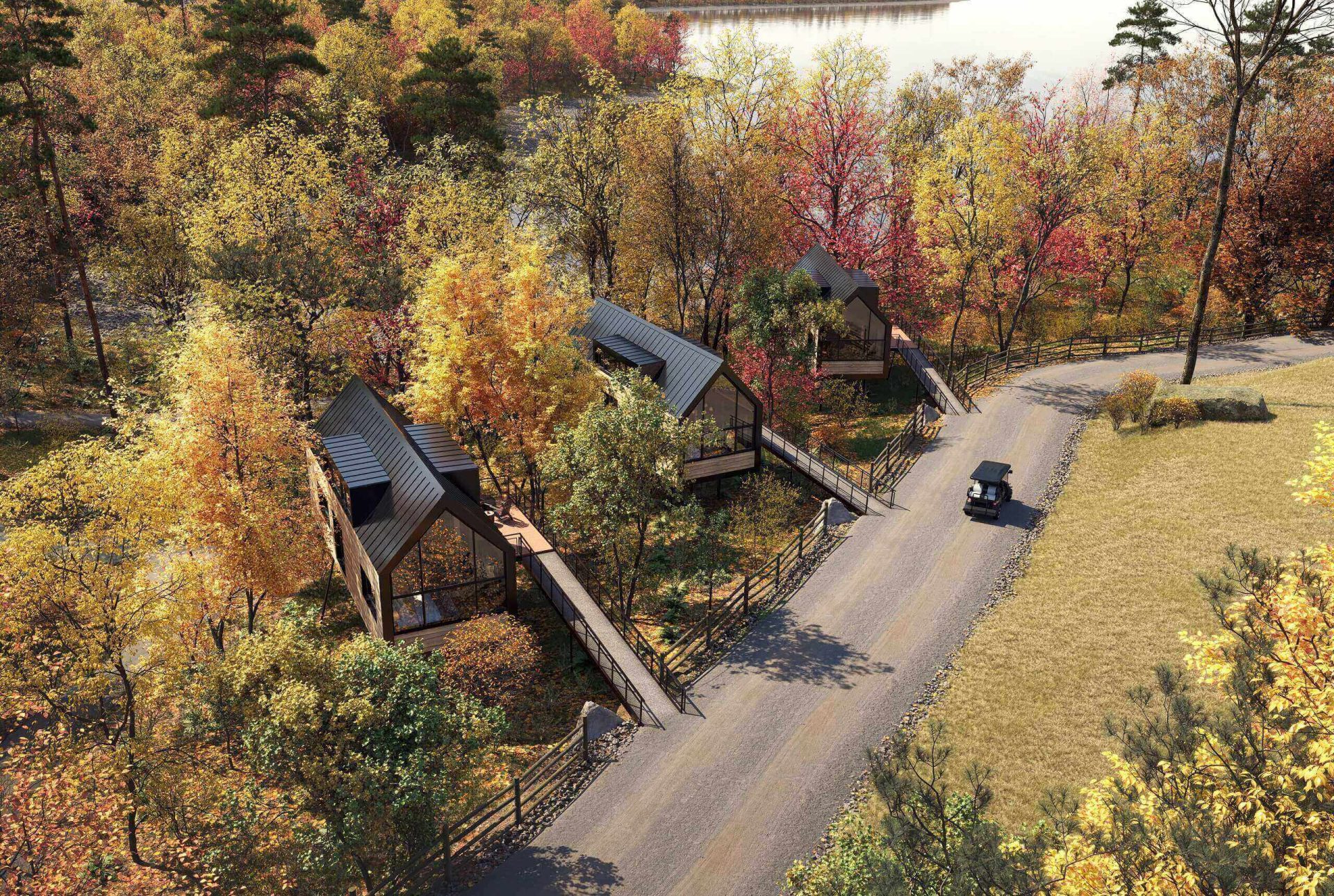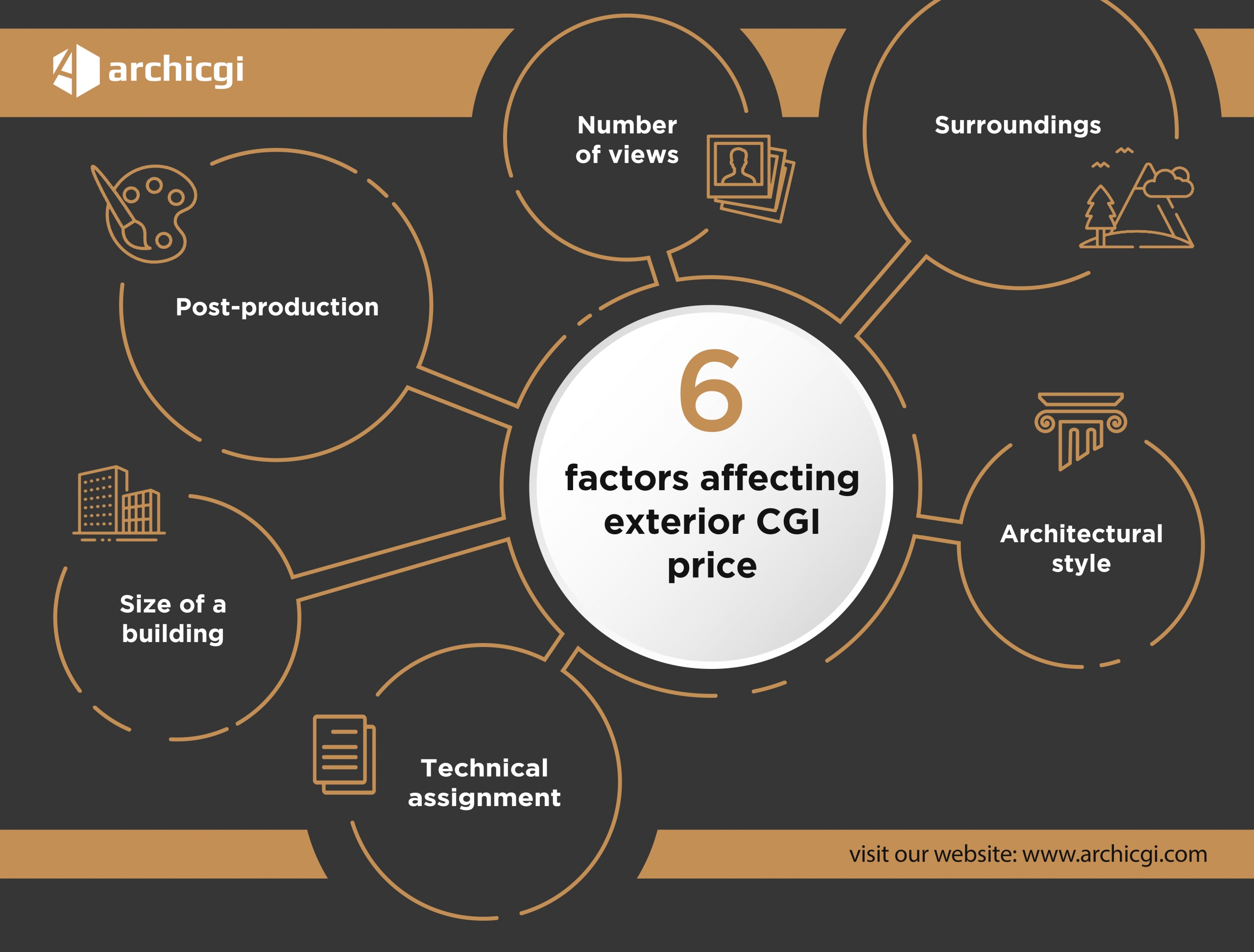Exterior 3D rendering cost is what architects more and more often include in their presentational budgets. The benefits of a photoreal architectural visualization are obvious – the client gets a clear view of the project as if it was already built, and the picture looks more impressive and convincing than a hand-drawn sketch. As a result, the architect delivers his or her vision more efficiently and gets more enthusiastic approval.
An architectural 3D rendering company will do a visualization project of any complexity with any level of detail. Common sense says 3D visualization cost varies proportionally to the amount of work, but one question remains open: what exactly forms the rendering price?
With this knowledge, architects understand exactly what they pay for. This way, they gain more control of the price and the way the visualization affects customers. And when in need to reduce the cost, a well-informed architect can do so by removing a few non-critical features. So today, we are sharing with you five main criteria affecting the exterior 3d rendering cost that will act as a road map for you.
#1. Brief Influences 3D Visualization Price

A project brief can greatly affect exterior 3D rendering cost. Why so? That’s because, with detailed drawings and many visual references, 3D artists understand the concept of an architect’s design perfectly from the very beginning of work. Which is exactly why they become able to recreate it in exterior CGI with the greatest precision possible. This means there will be no need for many rounds of corrections that could increase the cost. Moreover, a comprehensive brief also speeds up the workflow. With a detailed assignment, a CGI visualization team can complete an exterior 3D rendering project up to 30% faster.
#2. Scale Defines the Rendering Cost
Depending on how much area a building is going to occupy and whether you can reach for the stars from the roof, a team of 3D artists will be modeling it for several days or just a few hours. Exterior visualizations come in all shapes and sizes. They can show any type of architectural object and range from a cozy cottage to a stylish townhouse rendering. Each of them needs separate consideration when it comes to the exterior rendering price.
#3. Environment Affects Exterior Rendering Prices

Along with the project size, the background and environment also make a difference to the exterior 3D rendering cost. The more work a 3D artist has to do, the higher is the price. Here are three main types of environment arranged by complexity:
- A photo is the lowest-cost surrounding ever available. It is excellent for demonstrating the difference the project is going to make. A photo can be found on the Web, taken from the ground or a drone. The resulting render looks excellent, and it takes less time to create. The technique used to combine 3D rendering scene with a photo is called photo matching.
- Ghost buildings in the world of 3D visualization are diaphanous low-poly models. Easy and fast to create, they put a project into an unobtrusive context where nothing distracts from the architect’s vision.
- Photoreal environment rendering is able to mesmerize the audience. Whether it is a breathtaking landscape or an elaborated neighborhood of lifelike buildings, the most presentable surrounding will accompany the project. Obviously, such a background requires an extra amount of modeling and texturing work, and it results in the highest wow factor. Small wonder that architects often decide for a realistic surrounding: the presentation absorbs viewers, so the price pays off by far.
As you see the environment has an impact on the exterior 3D rendering cost, and there’s always an option for various project goals and budgets. For architects and designers to choose the best 3D solutions that will do the job and stay right on budget, we’ve revealed a few secrets on how to save money while getting high-quality CGI rendering.
Take your design presentation to a new level with interior rendering
#4. Exterior 3D Rendering Cost Depends on Architectural Style

The more complex forms and decorations the artists use, the more work a 3D visualization studio has to do. Although the style doesn’t determine the number of details directly, some tendencies are obvious. Generally speaking, Modernist architecture is among the easiest to model. The more detailed High-Tech and Classicism tend to be more laborious, followed by Baroque. As a rule, Neo-Gothic needs even more time and effort due to its abundant ornamentation. In this way, aesthetics influence the cost of 3D rendering.
#5. The Views Account for 3D Visualization Cost

Different buildings look best from different perspectives, and some architectural designs need viewing from several angles to show all their splendor.
A front or angle view is a good pick for a balcony or porch. The angle view requires some surrounding, resulting in a higher exterior 3D rendering cost. For the same reason, the general view contributes more to the rendering cost, followed by the bird view, which embraces the largest area. While the general view is the most common choice in exterior 3D rendering, several bird’s-eye perspectives or a single bird-view animation deliver the advantages of the design more effectively as they show it from multiple viewpoints. Also, it’s more impressive as it contrasts with our everyday experience where there’s no flight or glide.
The windows may shine softly, reflect the neighborhood, or cast light on the ground. They can be covered with blinds or left to reveal the interior if you want. The latter option adds value to your project. It’s not just a house now. It’s a home to live in! On the flip side, interior elements increase the amount of modeling work. This will increase the 3D visualization cost.
You should keep this aspect in mind before starting the project. This type of work requires more expertise. Namely, you will need the services of a 3D exterior and 3D interior renderings company.
#6. Post-Production Adds Value to Exterior 3D Rendering
The main purpose of the post-production stage is to make a render more organic and realistic. Its minuteness also results in variations of architectural rendering prices. Details such as people reading, pets playing, and cars driving into the garage increase the cost, but the effect they have is tremendous: the picture lives its own life, and the client wants to belong there. Different weather conditions make the visualization atmosphere solemn or playful, funny or dramatic. The picture above radiates calmness and peacefulness due to the cool weather and the people strolling around and socializing.
As you can see, the exterior 3D rendering cost is affected mainly by the scope of a brief, the size and style of the project, the way the neighborhood is created, the types and number of views, and the depth of post-processing. Only the geometry of the building is predefined, while the rest of the factors are under your thumb.

Want to empower your presentations? Contact the architectural animation company ArchiCGI. We will create 3D videos and stills that will impress your clients.
Immerse clients into your projects with realistic 3D animations
To start your own exterior visualization project, contact ArchiCGI and get high-quality photoreal renderings able to fascinate any viewer.

Irma Prus
Content Writer, Copywriter
Irma writes articles and marketing copy for ArchiCGI. Her dream is that more people discover the power of CGI for architecture. Irma is into neuromarketing, ruby chocolate and Doctor Who series.



